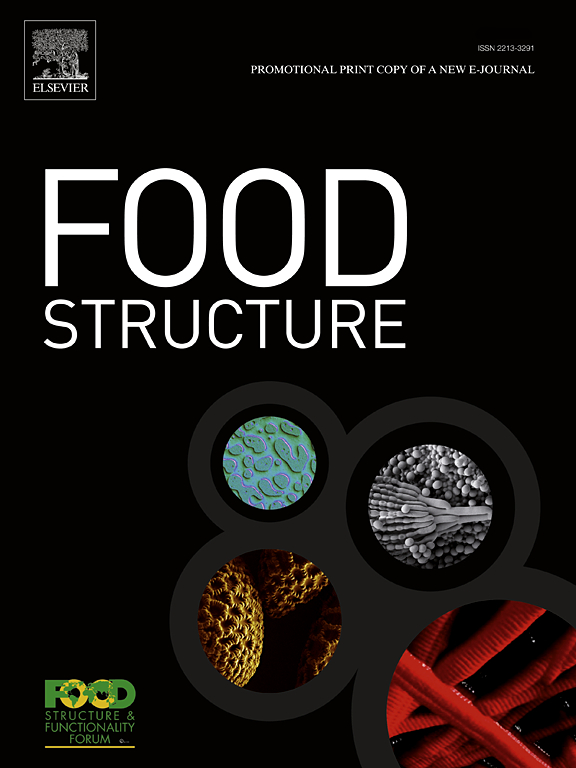Multi-structural characterization of sorghum flour addition on bread staling dynamics: texture, thermal properties and molecular mobility
IF 5.9
3区 农林科学
Q1 FOOD SCIENCE & TECHNOLOGY
引用次数: 0
Abstract
The effect of sorghum flour inclusion (0 %, 10 %, 20 %, and 30 %) on the quality and staling of composite wheat-sorghum bread was investigated, to explore its potential as a sustainable alternative in breadmaking. Fresh bread samples were characterized for color, specific volume, and stored up to 8 days at 25°C. Staling was evaluated at different structural levels, from the macroscopic to the mesoscopic, and molecular levels (water activity and moisture content, texture, thermal properties by DSC, and 1H molecular mobility and dynamics by 1H NMR Relaxometry). Sorghum addition resulted in darker bread and reduced specific volume compared to standard wheat bread. Sorghum-containing breads exhibited higher frozen water content, reflecting weaker water-biopolymer interactions at the mesoscopic level. Texture analysis revealed increased hardness and decreased cohesiveness with higher sorghum levels, while 10 % sorghum enhanced springiness. Molecular mobility assessments indicated that sorghum inclusion increased the rigidity of the starch-gluten-water network, which was associated with hardness. DSC analysis showed increased amylopectin retrogradation during storage, though no clear trend was associated with sorghum content. This multilevel structural approach revealed that sorghum addition generally intensified staling in composite bread, with 10 % inclusion partially mitigating staling-promoting effects. Integrated structural analyses are key to understanding staling dynamics and guiding strategies to enhance sorghum-based bread quality and shelf life.
添加高粱粉对面包变质动力学的多结构表征:质地、热性能和分子迁移率
研究了高粱粉掺入量(0 %、10 %、20 %和30 %)对小麦-高粱复合面包品质和变质的影响,探讨了其作为可持续面包替代品的潜力。对新鲜面包样品的颜色、比容进行了表征,并在25°C下保存了8天。从宏观到介观,以及分子水平(水活度和水分含量、质地、DSC热性能、1H核磁共振弛豫仪1H分子迁移率和动力学),在不同的结构水平上对变质进行了评估。与标准小麦面包相比,高粱的添加导致面包颜色更深,比容降低。含高粱面包具有较高的冷冻含水量,反映了介观水平上较弱的水-生物聚合物相互作用。织构分析表明,高粱含量越高,硬度越高,黏结性越低,而10% %高粱的弹性越强。分子迁移率评估表明,高粱包裹物增加了淀粉-谷蛋白-水网络的刚性,这与硬度有关。DSC分析表明,在贮藏过程中支链淀粉的退化增加,但与高粱含量没有明显的关系。多层结构分析表明,高粱的添加普遍加剧了复合面包的霉变,10% %的添加量部分缓解了霉变促进作用。综合结构分析是了解高粱面包变质动力学和提高高粱面包品质和保质期的指导策略的关键。
本文章由计算机程序翻译,如有差异,请以英文原文为准。
求助全文
约1分钟内获得全文
求助全文
来源期刊

Food Structure-Netherlands
Chemical Engineering-Bioengineering
CiteScore
7.20
自引率
0.00%
发文量
48
期刊介绍:
Food Structure is the premier international forum devoted to the publication of high-quality original research on food structure. The focus of this journal is on food structure in the context of its relationship with molecular composition, processing and macroscopic properties (e.g., shelf stability, sensory properties, etc.). Manuscripts that only report qualitative findings and micrographs and that lack sound hypothesis-driven, quantitative structure-function research are not accepted. Significance of the research findings for the food science community and/or industry must also be highlighted.
 求助内容:
求助内容: 应助结果提醒方式:
应助结果提醒方式:


